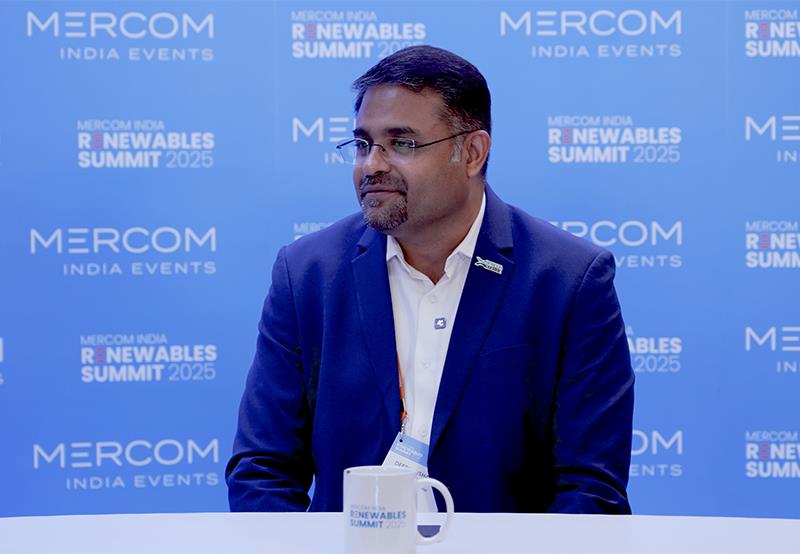Standardization and Innovation Key to Floating Solar Expansion: Interview
Surveys indicate a potential of up to 800 GW for floating solar in India
August 13, 2025
Follow Mercom India on WhatsApp for exclusive updates on clean energy news and insights
In an interview on the sidelines of the Mercom India Renewables Summit 2025 held in New Delhi on July 24 and 25, 2025, Deepak Ushadevi, MD and CEO at Ciel et Terre Solar, noted that floating solar is set to become a major driver of India’s renewable energy growth and not just a niche segment offering key advantages over ground-mount systems, such as no land acquisition issues, faster scalability, and higher generation.
In renewable energy, ground-mounted and rooftop solar have been the two main drivers. How do you see floating solar fitting into this picture?
Floating solar is not the third driver; it is a big driver in itself. We have been instrumental in taking floating solar to the next level and are market leaders in the space. We started two years ago and today have close to 500 MW of projects in India, which demonstrates both our capabilities and the sector’s potential. Floating solar addresses the core problem of land acquisition delays and the use of fertile land for projects.
India has vast untapped water bodies, and our surveys indicate that over 500 to 800 GW of capacity could be developed on them. With strong design expertise, guidelines, and technical know-how, floating solar has moved from concept to reality. It offers advantages such as no land acquisition issues, faster scaling, and a three to four percent higher generation rate, which offsets the small additional cost.
Why is floating solar slightly more expensive compared to ground-mount solar?
Initially, it was on the higher side, but costs have decreased due to innovation, technology adoption, and the development of indigenous vendors under the Make in India initiative. Lessons learned from past projects have also helped. In high-cost areas or industrial clusters where land is unavailable, floating solar is an excellent alternative. The cost gap has now narrowed to approximately eight to ten percent, and we expect it to continue narrowing as we continue to innovate and improve our engineering methods.
Earlier, most pilot floating projects were located on the reservoirs of thermal power plants. Now we see a much wider range of water bodies being used. What challenges do you face as a floating solar developer?
When we started in 2011–2012, we worked on small water bodies. Now projects are being developed on larger water bodies, including industrial ponds and open reservoirs. The key challenge in these larger sites is wave impact. Previously, waves were not a concern, but with open reservoirs and long fetch, wind-driven waves become a serious design factor.
Another challenge is anchoring and mooring. Earlier, we dealt with depths of two to five meters, but now it can be 15 to 30 meters with fluctuating water levels. Innovations in anchoring and mooring are essential to ensure the system remains intact for 25 years under constant wave and wind forces.
In one of your projects, you used rock bolting and floating barges. Could you explain these innovations?
The rock bolting system was developed in collaboration with experts from Germany, France, and India. In certain sites where the underwater terrain is rocky, traditional anchoring with dead weights is not ideal. Rock bolting allows us to penetrate the rock and secure the anchors directly, ensuring stability. The second innovation is fiber-reinforced plastic (FRP)-based floating barges with class approvals. Traditional concrete barges are well-suited for use in still waters, but they are not ideal for areas with constant wave action. FRP barges are stronger, more durable, and responsive to waves, making them suitable for harsh conditions. They also have modular pockets that allow for maintenance without requiring towing back to shore, which reduces downtime and costs.
Last year, you mentioned that there were gaps in certifications and standards for floating solar. Has there been progress?
There has been some progress. I have been involved in policy discussions and standardization efforts with agencies like the Bureau of Indian Standards and the Ministry of New and Renewable Energy. Standardization is important for the sustainable growth of floating solar and to ensure knowledge sharing within the industry. Some states, such as Kerala, have issued draft floating solar policies; however, more states need to follow suit. Floating solar is crucial to preserving land, conserving water, and contributing to India’s renewable energy targets of 500 GW by 2030, including 280 GW of solar energy.
What is your roadmap for Ciel & Terre India in the near and medium term?
We aim to remain industry leaders through bold innovations and large-scale installations. Our target is to have a gigawatt-scale portfolio within the next three to four years and achieve 10 to 15 GW within five to eight years, with a market share of at least 50% in floating solar. We will continue to work on technology leadership, policy advocacy, and scaling up floating solar wherever possible, preserving land and water while contributing to India’s clean energy goals.
(Note: Sections of the interview have been paraphrased for better reading. Check out the video for a full chat)
